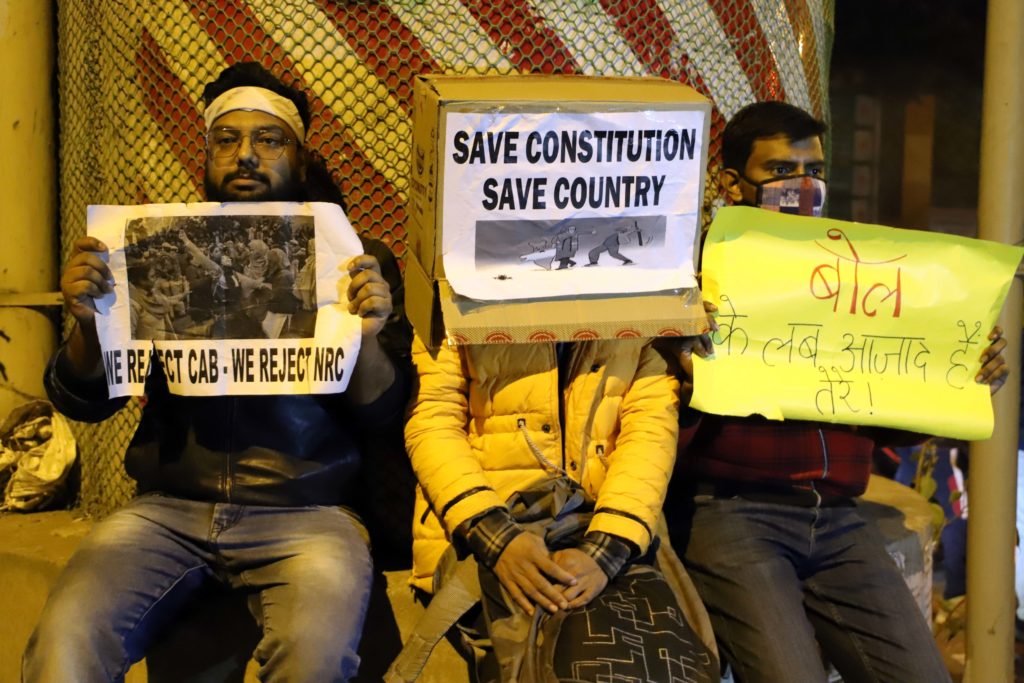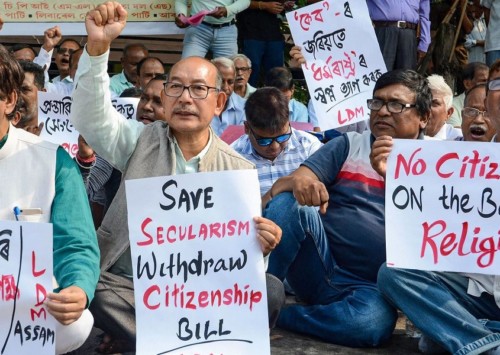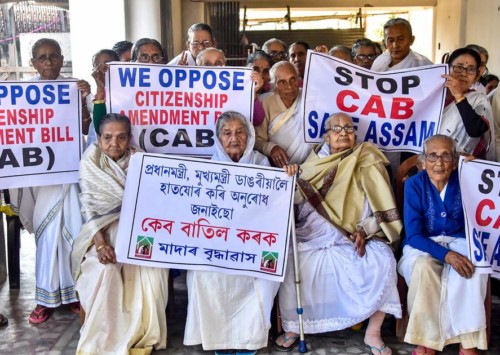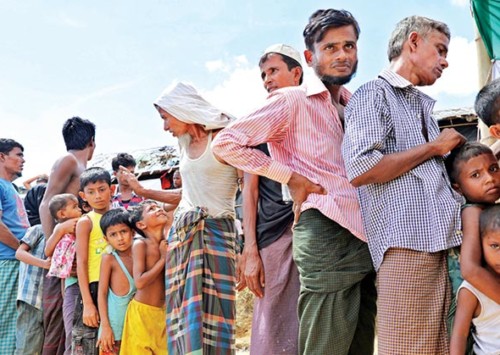Student power on display

The prolonged silence of the students has suddenly turned into a hubbub (Pic courtesy: Aman Kanojiya)
After years of relative calm, protests have gripped university campuses across the nation. Does this signal a new phase in Indian politics?
The numerous ongoing protests by student bodies against the Citizenship (Amendment) Act, 2019, and in some places the National Register of Citizens (NRC), have gripped the nation’s attention and are being talked of even overseas. What is remarkable is that the protests by the students is not influenced by the agenda of any organisational structure or for that matter any political party.
The current scenario is in many ways similar to the situation prevailing in India in the years 2012-13 when thousands of students had pro-actively protested against the government of the day on various issues including women’s safety and corruption and the protestors were mainly apolitical though the ruling Congress party ended up paying a steep penalty and has been in near wilderness ever since.
However, soon after the change in the government after the 2014 elections, the students seemed to have disappeared from the streets almost entirely, even though there were several issues facing them, notably the rise in unemployment, the rising costs and falling standards of education, increasing air pollution and climate change.
The prolonged silence of the students has suddenly turned into a hubbub. It all started in Assam when the controversial Act was passed and the All Assam Students’ Union organised protests, despite attempts to ban student participation in political activities relating to the Act. The ferocity of the protests and the students’ determination seemed to have caught the government by surprise. They may have done well to remember that students in Assam have been playing a prominent role in the state’s politics over the past four decades and it still continues.
The protests then took over the entire north-east region when students from Meghalaya, Tripura and Sikkim also joined in. It was a catch-22 situation for the political parties as they could not figure out their stand on the issue. Soon enough the protests reached the capital as well and made global headlines when the highhanded approach of the police against protesting students of Jamia Millia Islamia University was highlighted. The police had barged into the campus, shot teargas shells at various locations, including the library where several students were studying, and caned students after dragging them out of the campus. Videos of these sights went viral on the social media across the globe.
Though less visible, the students in Aligarh Muslim University faced a similar response from the police that seemed keen to ensure that protests, even peaceful ones, did not occur there at all, leading to clashes with the students.
However, this time the voices of these students gained support from millions of students from around the country. Students gathered on the streets in Punjab, Varanasi, Kolkata, Mumbai, Gujarat, including the southern states Telangana, Tamil Nadu, Puducherry, Karnataka and Kerala. In Delhi too students of Delhi University (DU) and Jawaharlal Nehru University (JNU) joined the protests, students boycotting examinations in the DU. In Kolkata, student of Jadavpur University (JU) and Presidency University staged protests against the police action in Jamia and Aligarh and also against the CAA.
A poster at IIT Kanpur read: “They struck down the students’ retaliation at Jadavpur University. We didn’t respond. They hiked the MTech fees, we didn’t respond. Manhandled the student protesters at JNU, we didn’t respond. And now its JMI and AMU. Our commitment towards the students’ community is under huge jeopardy if we don’t respond now. Therefore, let’s come together for a campus-wide march in solidarity with students of Jamia Millia Islamia and Aligarh Muslim University.”
“Public universities have had a long history throughout the world of standing up against injustice. These university students are actually a part of that long historical tradition. The government is scared of these protests because it knows the potency of these protests. Anti war protests by American students against Vietnam War had changed the public discourse which was initially supporting the Vietnam War. Similarly for CAA the public initially supported the bill presented by the ruling government, but that very discourse has developed its own fault lines and failures, the public discourse through continued protests can and will change in favour of scrapping the bill,” Aameen, a student of Mumbai’s Tata Institute of Social Sciences (TISS), tells Media India Group.
Student bodies a constant target
Ever since the Bharatiya Janata Party (BJP) came to power in 2014, there’s one section that has constantly been on its radar. They are the students of the Jawaharlal Nehru University (JNU). In 2016, when a few student activists of JNU organised a rally on the anniversary of the hanging of Afzal Guru, the convict in the Parliament attack case, it eventually descended into skirmishes with Right-wing student activists, trying to disrupt the protests. Videos emerged on all media channels of students belting out slogans at the rally about wanting to break India apart. However, later it was proved that most of the videos were doctored.
At that point the ruling government then decided that the most important thing happening in India was a few student activists shouting slogans and jumped into the matter, sending police onto the campus and arresting a number of students, despite lack of evidence against them. The rhetoric from the government encouraged violence against these students, and indeed on several occasions, there were mobs beating up activists and even journalists soon after.
Jump to 2019. The university was once again targeted after the administration issued a massive fee hike in October. Hundreds of JNU students marched in protest towards the Indian parliament in mid November where they were stopped and baton charged by the police and paramilitary forces. And now JNU is no longer the only university on BJP’s radar. Joining them are the students of Jamia Millia Islamia University and the Aligarh Muslim University who have faced the wrath of the government after they protested against the CAA.
Some believe that the students’ protests could lead to dramatic changes in the country as has been the case with several countries, including India, in the past. Markandey Katju, a former Supreme Court judge, compared the ongoing protests to the May Fourth Movement in China. “The students’ agitation against the blatantly discriminatory Citizenship (Amendment) Act marks the beginning of the coming, historic revolution in India. This revolution will sweep away the filth of the centuries-old feudal reactionary practices, customs and mindsets; abolish poverty, unemployment, malnourishment, ignorance, farmers’ distress, lack of healthcare and other social evils plaguing the country; and usher India into an age of prosperity and justice for all,” Katju wrote in an article.
On accusations by supporters of the government that students were becoming political, actor turned politician Kamal Haasan said, “The young will have to be politically aware and be politicians. And there is nothing wrong with it. You make it sound like an infra dig and that is scholarly. This is omnipresence. Politics is omnipresent in their life and it affects it. They must understand it and they must question it and they must have the cognizance of politics and they must question these and these questions when stifled then democracy is in a dangerous ICU.”

Students of Jamia Millia Islamia University and the Aligarh Muslim University faced the wrath of the government after they protested against the CAA
Opportunity for opposition
The protests against the CAA have set an example for the country’s splintered opposition that has proved to be entirely ineffective in keeping proper checks and balances on the government and the parliamentary proceedings where several key laws have been rushed through without a proper debate or discussion. The students have shown the Opposition that it is possible to challenge the government and the ruling party on a nationwide scale if the agenda is for the rights of its people.
Some parties are indeed trying to ride the bandwagon. Seeing the sensitivity of the situation BJP’s erstwhile ally Shiv Sena, questioned the actions of the Delhi Police and in an editorial in its mouthpiece, Saamana, it condemned the lathi charge on the protesting students of Jawaharlal Nehru University (JNU).
Attacking the government and Delhi Police, Shiv Sena said, “Prime Minister Narendra Modi and the Bharatiya Janata Party (BJP) got their current position by protesting. If this kind of protest happened under the Congress government, the BJP would have protested in Parliament. The Akhil Bharatiya Vidyarthi Parishad (ABVP) would have given a call for a Bharat Bandh,” the editorial stated.
Similarly, Bengal’s chief minister Mamata Banerjee has lead massive protests in Kolkata and vowed not to allow NRC and CAA in West Bengal. Several hundred protesters also took to the streets in Kerala, another state that has said it will not allow the law to be introduced. Rahul Gandhi, the former head of the opposition Congress party, tweeted that the law was a “weapon of mass polarisation unleashed by fascists”. The ongoing protest marks a new stage in the relationship between students and this government which is making the same mistakes that the Congress had made and therefore lost power. Rights group Amnesty India reminded the government that “students have a right to protest”. The current agitation by students is a reminder to politicians that history has a tendency to repeat itself and those who forget the past do so at their own peril.
Media India Group was there at the Jamia protests and spoke to few of the students. Here is what the students and the participants had to say-
“All I say is once the students locked themselves in library, why did the police have to thrash everything? They could have arranged for their peaceful exit, screened them as culprit or suspect and have them arrested. I think we are living/headed towards dictatorship. The government passes whatever law they want, then shuts anyone who tries to speak against it. In Kashmir it’s been around five months, even UN didn’t do anything. So, I really don’t know who to look up to now,” says Garima Bansal, student, Jamia Millia Islamia University.
“I was present there myself for 3-4 hours. All the students were protesting silently. They all were behaving in a civilised manner. They didn’t want to bring bad name to their institution. And what did the police do? They tried to suppress the protest forcefully, in a very brutal manner. They misbehaved, especially with the girls. They say Beti Bachao Beti Padhao (save daughters, teach daughters), and what are they doing themselves? No one can trust them now, at least not the ones who were there,” says Daisy Fatima a local who had witnessed the protest.
“Even though, I don’t have a political agenda, I’ll keep protesting because this has become the need of the hour. What is happening is against students and minorities, says Sheeraz, MSC, Bioinformatics, final year.












